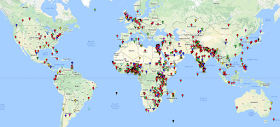 In the second of our
series of interviews with our ALPSP awards finalists we talk to Ann Michael,
President of Delta Think.
In the second of our
series of interviews with our ALPSP awards finalists we talk to Ann Michael,
President of Delta Think.
·
Tell us a bit about
your company
Delta
Think is a business and technology consulting firm focused on innovation and
growth in scholarly publishers and membership organizations. Founded at the
height of the transition from print to digital, our core purpose is helping
organizations to manage change. We live at the intersection of content, technology
and user experience, and help our clients through the many changes impacting
scholarly publishers and membership organizations.
·
What is the project
that you submitted for the Awards?
The
Delta Think Open
Access Data & Analytics Tool (OA DAT) is a
living compilation of industry data, anonymized private data and analysis,
which provides a comprehensive view of the OA market.
The idea originated with questions arising during consulting
engagements. We found commonality in questions clients asked about OA, with no
clear consolidated, reliable data source to address them. We saw an opportunity
to serve the industry more effectively by curating such a data set, and supplementing
it with analysis, commentary, and visualizations.
·
Tell us more about
how it works and the team behind it
The OA DAT includes several levels of analysis and
data access to accommodate any organization’s available bandwidth, comfort
level with data analytics, and budget. We’ve worked hard to build a consistent
view of the market and to make existing silos of data interoperate to deliver
new insights, supplementing them with publisher confidential data
(de-identified and aggregated).
The tool includes interactive visualizations so users
can extract meaning for real-world decision-making, while providing a quick way
to tailor the tool to areas of interest with a few mouse clicks. There is a
sample interactive visualization and a brief video on our website ,
and a few static images below.
Additionally, we curate and aggregate OA industry news
and combine it with a short analysis to publish Delta Think’s OA News &
Views, which is available free of charge with
registration.
We launched the Delta Think Open Access
Data & Analytics Tool
in beta to pre-launch subscribers in December of 2016, with our full launch in
January of 2017. The tool is continually updated. To keep the product current
and the user base growing, we work with two core data analysts (one with deep
database experience), a research associate, product manager, project manager,
marketer, and a business development resource
·
Why do you think it
demonstrates publishing innovation?
We
had two key motivations in developing the tool: generally increasing industry
data proficiency, and specifically supporting organizations as they make data
driven strategic and ongoing decisions around Open Access. While several
organizations have the bandwidth and budget to develop data analytics
expertise, most find using data in decision making aspirational and, at best,
episodic. It is not a part of their normal workflow.
On
one level, our innovation is pulling disparate information together and
continually updating it to provide benchmarks and genuinely novel insights into
the Open Access market.
But
the innovation goes much deeper: In a single product, we have created the
means for any organization to use data in OA decision making on an ongoing
basis.
· Organizations not equipped to interact with the
underlying data can read the analysis and benefit from its regular updates.
They don’t have to wait a year or two for an analyst report to be refreshed.
· Organizations looking to interact with the data
can manipulate visualizations, narrowing in on elements important to them
(e.g., geographic region, subspecialty, year, etc.).
· Organizations equipped to gather, normalize, and analyze
data and knowing the questions they want answered can export OA DAT data,
combine it with proprietary data, and complete their own analyses. They can
also use OA DAT to save time and effort in data collection, allowing them to
focus more on their proprietary analysis.
· For any of the above, our consulting resources
support targeted research or produce custom reports.
The tool is valuable and
accessible to the expert or the novice.
· What are your plans
for the future?
We
currently focus on STM + Social Science, OA, Journals, as well as not-for-profit
and commercial publishers. We plan to extend product coverage to books, open
data, and even overall scholarly output (overlaying analytics on top of the
usual indexes). We also plan to extend to institutional markets (both
librarians and research departments) and other industry players interested in
Open Access. Additionally, we are in confidential discussions with many potential
data and tech partners.
Our
bigger picture goal is to create extensions to the Delta Think Open Access
Data Analytics Tool and develop
other products or services supporting scholarly publishers, membership
organizations, and the multitude of players in the scholarly communications
ecosystem to build data and business analytics into their culture and their
workflows.
 Ann Michael is President of Delta Think, a
business and technology consulting and advisory firm focused on innovation and
growth in membership organizations and scholarly publishers. Ann is a Past
President of the Society for Scholarly Publishing (SSP), an NFAIS board member,
a Board Director at Joule (a Canadian Medical Association company), a frequent
organizer and speaker at industry conferences, and is a contributor to the
SSP’s blog, The Scholarly Kitchen.
Ann Michael is President of Delta Think, a
business and technology consulting and advisory firm focused on innovation and
growth in membership organizations and scholarly publishers. Ann is a Past
President of the Society for Scholarly Publishing (SSP), an NFAIS board member,
a Board Director at Joule (a Canadian Medical Association company), a frequent
organizer and speaker at industry conferences, and is a contributor to the
SSP’s blog, The Scholarly Kitchen.
Website: https://deltathink.com
Twitter: @deltathink @annmichael
LinkedIn: https://www.linkedin.com/in/annmichael
LinkedIn: https://www.linkedin.com/company/delta-think
Facebook: facebook.com/deltathink
See the ALPSP Awards for Innovation in Publishing Finalists lightning sessions at our Annual Conference on 13-15 September, where the winners will be announced.
The ALPSP Awards for Innovation in Publishing 2017 are sponsored by MPS Ltd.
LinkedIn: https://www.linkedin.com/in/annmichael
LinkedIn: https://www.linkedin.com/company/delta-think
Facebook: facebook.com/deltathink
See the ALPSP Awards for Innovation in Publishing Finalists lightning sessions at our Annual Conference on 13-15 September, where the winners will be announced.
The ALPSP Awards for Innovation in Publishing 2017 are sponsored by MPS Ltd.







